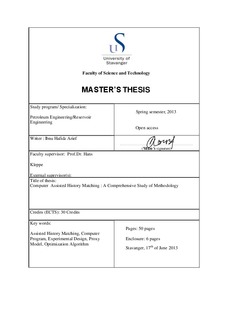Computer assisted history matching : A comprehensive study of methodology
Master thesis
Permanent lenke
http://hdl.handle.net/11250/183563Utgivelsesdato
2013-06-17Metadata
Vis full innførselSamlinger
Sammendrag
History matching is an important step in reservoir simulation study. The objective is to validate a reservoir model before it is used for prediction. In conventional way, people do history matching by manually adjusting uncertain parameters until an acceptable match is achieved. As a consequence, history matching becomes a delicate problem and consumes a lot of time. Furthermore, in several cases it is hard to obtain a match by manual process.
In order to have a more efficient history matching process, many researchers conducted studies by involving a computer based program to obtain a match. The method is normally called assisted history matching (AHM). One of the AHM methods involves the use of experimental design, proxy model and optimization algorithm. The basic concept of this method is to use proxy model which is generated from set of experiments to replace reservoir simulation in the optimization process. This method has practical application in the industry. However, without a proper understanding, using this method to solve a history matching problem would be as difficult as conventional way.
In this master thesis, an extensive study of AHM methodology is performed in order to have a comprehensive understanding on how the methodology solves a history matching problem. The methodology limitations are also identified so that proper improvements can be carried out. The main improvements are the introduction of average proxy error in objective function and the proposal of selecting response variables to become matching variables based on the quality of proxy model.
This study also investigates different experimental design methods, proxy models and global optimization algorithms. In experimental design subject, complete CCF design and fractional CCF design are elaborated. Two types of proxy models e.g. kriging and second polynomial equation were investigated. Four optimization algorithms e.g. simulated annealing, direct search, global search and genetic algorithm are analyzed to select the best performance algorithm. In the final stage, the improved methodology was used to solve history matching problem of two artificial study cases.
Beskrivelse
Master's thesis in Petroleum engineering
